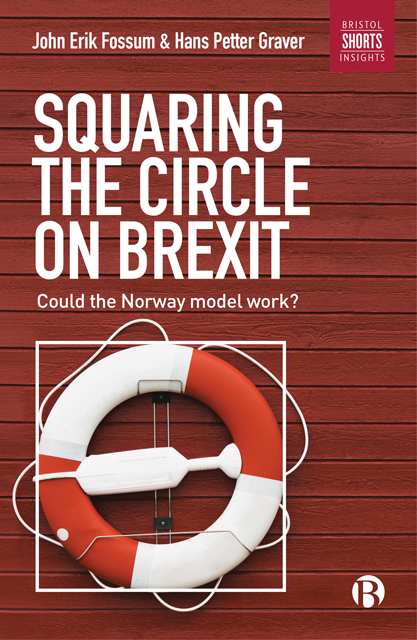Book contents
- Frontmatter
- Contents
- Foreword
- Preface and acknowledgements
- List of abbreviations
- Introduction
- 1 What does Britain want from Brexit?
- 2 Forms of affiliation with non-members
- 3 What is the Norway model?
- 4 The challenge of sovereignty
- 5 What can Britain learn from Norway’s experience?
- 6 Would Britain be an ‘elephant in the boat’?
- Conclusion
- Notes
- References
- Appendix
- Index
3 - What is the Norway model?
Published online by Cambridge University Press: 21 April 2023
- Frontmatter
- Contents
- Foreword
- Preface and acknowledgements
- List of abbreviations
- Introduction
- 1 What does Britain want from Brexit?
- 2 Forms of affiliation with non-members
- 3 What is the Norway model?
- 4 The challenge of sovereignty
- 5 What can Britain learn from Norway’s experience?
- 6 Would Britain be an ‘elephant in the boat’?
- Conclusion
- Notes
- References
- Appendix
- Index
Summary
Norway is associated with the EU through more than 130 agreements, ranging from the internal market, Schengen association agreements, agreements on asylum and police cooperation (Dublin I, II and III), agreements on foreign and security policy (Norway participates in the EU’s battle groups), agreements on internal security and justice, fisheries, agriculture, to mention a few (see Appendix I). Through these agreements, Norway has incorporated roughly three-quarters of EU legislation compared to those EU member states that have incorporated everything (NOU 2012:2, 3). Key areas that fall outside the scope of the cooperation are the euro, the customs union and foreign trade policy, the Common Agricultural Policy and taxation. Even some of these areas are affected by the rules of the single market. Free movement of capital affects taxation rules, and a substantial number of veterinary and food safety rules are included in the agreement.
The EEA Agreement is beyond doubt the main feature of the Norway model. In contrast to Switzerland’s (wide range of) sectoral bilateral agreements, the EEA Agreement is a broad and dynamic multilateral agreement between the (currently) 28 EU member states and the three EFTA states of Iceland, Liechtenstein and Norway. The EEA brings together the EU member states and the three EFTA states in a single market based on the internal market of the EU. It should be noted that the UK was one of the main initiators of EFTA in 1960, and left EFTA when it joined the EU in 1972.
Within the scope of the EEA Agreement, the rules of the internal market extend to the whole EEA, with the result that people, services, goods and capital can move freely. The EEA Agreement guarantees equal rights and obligations within the internal market for citizens and economic operators in the EEA. The EEA is, however, not a supranational legal order, and contrary to the EU member states, the EFTA states retain, formally speaking, their legislative and judicial sovereignty. The EEA is limited in scope compared to the cooperation within the EU, and does not include such areas as agriculture and fisheries, the Monetary Union or justice and home affairs, to list some of the differences. In addition to the rules of the single market, the agreement also includes other areas such as research and development, education, social policy, the environment, consumer protection, tourism and culture – collectively known as ‘flanking and horizontal’ policies.
- Type
- Chapter
- Information
- Squaring the Circle on BrexitCould the Norway Model Work?, pp. 41 - 62Publisher: Bristol University PressPrint publication year: 2018

